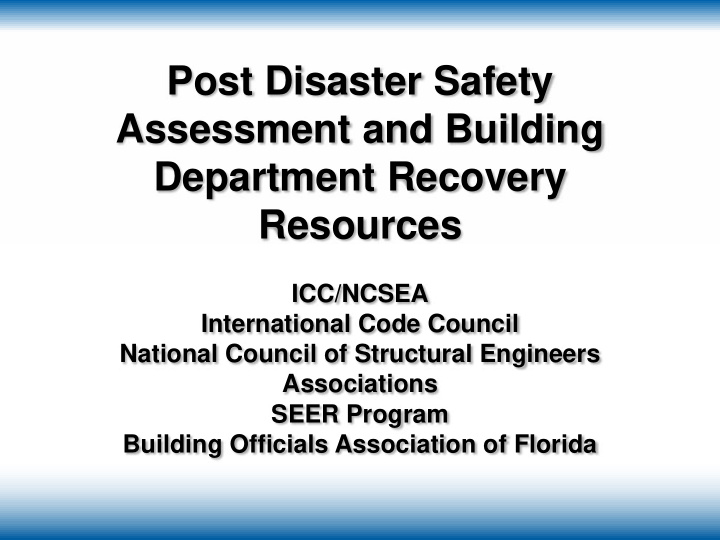



Post Disaster Safety Assessment and Building Department Recovery Resources ICC/NCSEA International Code Council National Council of Structural Engineers Associations SEER Program Building Officials Association of Florida
Our Topics Post Disaster Safety Assessment: The Resource W. Doug Douglass NCSEA SEER 2 nd Responder Roster, SME Lead Training Specialist at Public Safety Specialists Building Officials Association of Florida Mutual Aid System and Lessons Learned from 2017 Kathleen Croteau, CBO CFM BOAF Mutual Aid Chair Sarasota County Florida Building Official Post Disaster Safety Assessment: Success Stories from 2017 Ron Rogers NCSEA SEER Committee Director Public Safety Specialists
No Community is Immune In 2016 More than 100 million people within the US (1/3 of it’s population) were adversely impacted by a natural disaster Date (2016) Event Area Effected Southeast, Mid Atlantic & 103 M people & January Blizzard Northeast (11 States) 10,000’s Buildings Appellation Mountains Infrastructure & June Flood (2 States) 1000’s of buildings Infrastructure & August Flood Louisiana 1000’s of buildings August / Tropical Storm Southeast Infrastructure & September & Flood (3 States) 1000’s of buildings
What Is Recovery? The task of restoring the infrastructure and returning a community to normal operation
A Tale of Two Communities 5
A Tale of Two Communities Biloxi ▪ This community experienced the Northeast quadrant of the storm with winds in excess of 140 mph and a Storm Surge depth ranging from 13 to 27 feet ▪ The coastal and downtown communities were evacuated and closed to residents for 5 days ▪ Building assessments of ALL coastal, downtown and commercial structures were completed within 1 month after the storm 6
A Tale of Two Communities Biloxi (today) ▪ ALL of the catastrophically damaged structures were razed within 3 months of the storm ▪ More than 90 percent of its residents returned to the community after the storm ▪ The community has experienced redevelopment and growth 7
A Tale of Two Communities St. Bernard Parish ▪ The levees surrounding the Parish breached during the storm which resulted in flooding that ranged from 3 to 20 feet deep ▪ The entire Parish was evacuated and closed to residents for 3 months after storm ▪ Limited building assessments commenced approximately 3 months after the storm and took more than 1 year to complete 8
A Tale of Two Communities St. Bernard Parish (today) ▪ Due to abandonment, the severely damaged structures became catastrophically damaged ▪ It took several years to raze the catastrophically damaged structures ▪ 1 year after the storm roughly 50% of its residents returned to the community ▪ Not all of its infrastructure and businesses have been restored or returned 9
How Does Recovery Begin? By utilizing 2 nd Responders to determine whether structures are suitable for re-habitation
What is A 2 nd Responder? A trained and qualified individual (resource) capable of performing post-disaster damage assessments
2 nd Responders There are 4 recognized classes of 2 nd Responders: • FEMA Structure Condition Evaluator (SCE) • ICC Disaster Response Inspector (DRI) • CalOES SAP Assessor • ATC 20 or 45 Assessor
2 nd Responders
NCSEA SEER MISSION: To develop, manage and deploy professional 2 nd responders (Damage/ Safety Assessment Professionals) who are properly trained and certified both domestically and internationally
NCSEA SEER and ICC SCOPE: ▪ Training – Facilitating and/or delivering 2 nd responder training to volunteers ▪ Advocacy – Advocating and educating AHJs and other stakeholders on the benefits and use of 2 nd responders
NCSEA SEER and ICC SCOPE: ▪ Roster Management – Compiling and maintaining a national roster of 2 nd responders including building officials ▪ Assistance Coordination – Coordinating and/or providing 2 nd responder assistance to AHJs or other stakeholders
2 nd Responder Roster A database of trained and certified 2 nd responders who are willing to assist with post-disaster condition assessments of structures at a local, State or national level
2 nd Responder Roster This system is thriving and is supported by NCSEA and ICC http://www.ncsea-seer.com/
Locating 2 nd Responders Currently the roster Roster Reports includes 1500+ trained individuals
Deploying 2 nd Responders
Deploying 2 nd Responders There are 3 methods of activating 2 nd Responders: • Federal Resource (Request Through EM) • State Resource (Request Through EM or BOA) • Volunteer (Direct Request)
Deploying 2 nd Responders EMAC Request
Deploying 2 nd Responders Local Request Within State
Deploying 2 nd Responders National Request SEA/BOA Members In Each State And Region
2017 Deployments
2017 Deployments
2017 Deployments
Hurricane Irma: Florida Keys
Hurricane Irma: Florida Keys
Hurricane Irma: Florida Keys
Hurricane Irma: Florida Keys
Hurricane Irma: Florida Keys
Hurricane Irma: Florida Keys
Hurricane Irma: Florida Keys
ATC – 20 and ATC – 45 Standard Utilizing 2 nd Responders to determine whether structures are suitable for re-habitation
Hurricane Irma: Florida Keys
Hurricane Irma: Florida Keys
Hurricane Irma: Florida Keys
Post Disaster Safety Assessment and Building Department Recovery Resources
W. Doug Douglass NCSEA SEER 2 nd Responder Roster, SME Public Safety Specialists Lead Training Specialist Email: wdouglass@2ndresponder.com Phone: 813-748-1462 Ron Rogers NCSEA SEER Committee Public Safety Specialists Director Email: rrogers@2ndresponder.com Phone: 813-676-1019 Kathleen Croteau, CBO CFM BOAF Mutual Aid Chair Sarasota County Building Official Planning and Development Services Email: kcroteau@scgov.net Phone: 941-861-6020
Recommend
More recommend